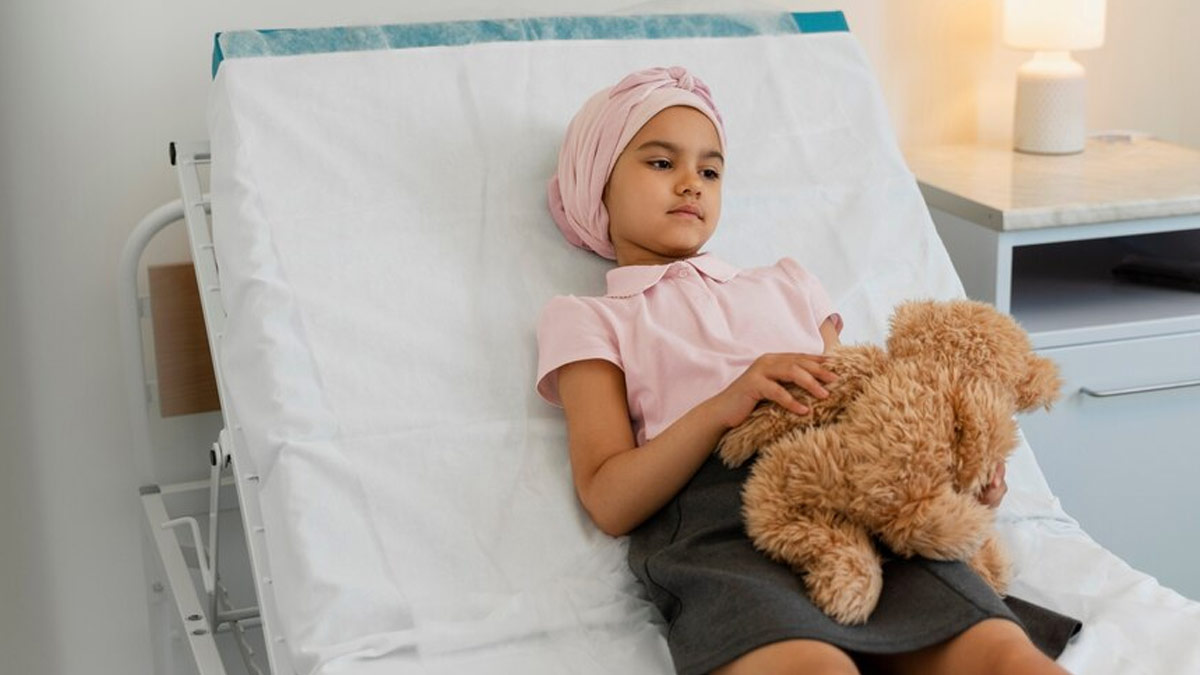
Paediatric cancer remains a significant concern due to its profound impact on young lives and their families. Unlike adult cancers, paediatric cancers often arise from genetic mutations rather than lifestyle or environmental factors, and they require specialised approaches to treatment and care. Early detection and understanding of these cancers can greatly improve outcomes. Here are five types of paediatric cancer that parents and caregivers should be aware of. We spoke to our expert Dr Ushma Singh, Director of Pediatric Oncology and Hematology, Andromeda Cancer Hospital, Sonipat, who explained the types of paediatric cancer, their symptoms, and treatment.
Table of Content:-
Types of Paediatric Cancer
1. Leukaemia

“Leukaemia is the most prevalent cancer in children, making up about 30% of all paediatric cancer cases. It originates in the bone marrow and results in the production of abnormal White Blood Cells (WBCs). This can replace normal blood cells in the bone marrow resulting in the overproduction of abnormal blast cells with abraded functioning,” said Dr Singh.
This results in anaemia, WBCs with abnormal functioning and immunity presenting as infection, and lower platelets count presenting with bleeding or petechial spots on the skin. The main types of childhood leukaemia are Acute Lymphoblastic Leukaemia (ALL) and Acute Myeloid Leukaemia (AML).
Symptoms
- Fatigue
- Frequent infections
- Unexplained bruising or bleeding
- Bone and joint pain
- Swollen lymph nodes
Treatment
- Chemotherapy
- In some cases, radiation therapy or stem cell transplantation may be necessary
Also Read: Cancer Complications: Expert Explains Its Life-Threatening Complications And Management Measures
2. Brain and Central Nervous System (CNS) Tumours

“Brain and CNS tumours are the second most common cancers in children. They can occur in various parts of the brain and spinal cord, with medulloblastomas and gliomas being the most prevalent,” said Dr Singh.
Symptoms
- Headaches
- Nausea
- Vomiting
- Balance problems
- Vision, hearing, and speech issues
- Seizures
Treatment
Treatment depends on the tumour's location and type and may include:
- Surgery
- Radiation therapy
- Chemotherapy
3. Neuroblastoma

Neuroblastoma is a cancer that arises from immature nerve cells and mainly affects infants and young children. It usually starts in the adrenal glands but can also develop in nerve tissues along the spine.
Symptoms
- Abdominal pain
- A painless lump under the skin
- Changes in bowel habits
- Difficulty breathing
Treatment
Treatment options vary by stage and may include:
- Surgery
- Chemotherapy
- Radiation therapy
- Stem cell transplant
- Immunotherapy
Also Read: Recurrence Of Cancer: Experts Explain Why, How, And What You Should Do?
4. Wilms Tumour

“Wilms tumour, or nephroblastoma, is a form of kidney cancer that primarily affects children between the ages of 3-4. It usually presents as a painless abdominal mass,” added Dr Singh.
Symptoms
- Abdominal swelling or a lump
- Fever
- Nausea
- Blood in the urine
- Constipation
Treatment
- Combination of surgery
- Chemotherapy
- In some cases, radiation therapy
5. Lymphoma

Lymphomas, including Hodgkin and non-Hodgkin lymphoma, are cancers of the lymphatic system. Hodgkin lymphoma is more common in adolescents, while non-Hodgkin lymphoma tends to affect younger children.
According to the American Cancer Society, Hodgkin lymphoma is most frequently diagnosed in early adulthood (typically among those in their 20s) and later adulthood (after age 55). While it can also appear in children and teenagers, it is uncommon in children under five. On the other hand, non-Hodgkin lymphoma is more prevalent in younger children compared to Hodgkin lymphoma, though it remains rare in those under three.
Symptoms
- Swollen lymph nodes
- Fever
- Night sweats
- Weight loss
- Fatigue
Treatment
- Chemotherapy
- Sometimes radiation therapy and stem cell transplant may be used
Bottomline
Dr Singh concluded, “While paediatric cancers pose significant challenges, advances in medical science have greatly improved the prognosis of many young patients. Awareness and early detection remain crucial in the fight against these diseases. Routine check-ups and swift attention to any unusual symptoms can significantly improve outcomes.”
[Disclaimer: This article contains information provided by an expert and is for informational purposes only. Hence, we advise you to consult your own professional if you are dealing with any health issues to avoid complications.]
Also watch this video
How we keep this article up to date:
We work with experts and keep a close eye on the latest in health and wellness. Whenever there is a new research or helpful information, we update our articles with accurate and useful advice.
Current Version